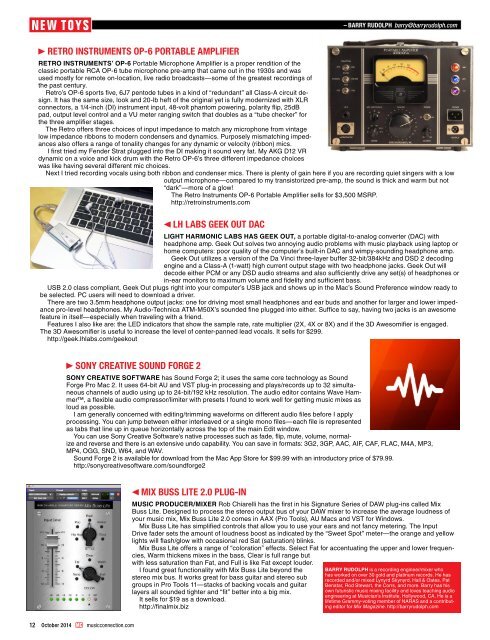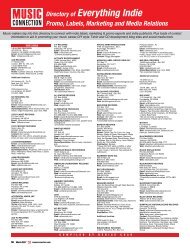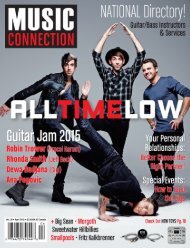You also want an ePaper? Increase the reach of your titles
YUMPU automatically turns print PDFs into web optimized ePapers that Google loves.
– BARRY RUDOLPH barry@barryrudolph.com<br />
RETRO INSTRUMENTS OP-6 PORTABLE AMPLIFIER<br />
RETRO INSTRUMENTS’ OP-6 Portable Microphone Amplifier is a proper rendition of the<br />
classic portable RCA OP-6 tube microphone pre-amp that came out in the 1930s and was<br />
used mostly for remote on-location, live radio broadcasts—some of the greatest recordings of<br />
the past century.<br />
Retro’s OP-6 sports five, 6J7 pentode tubes in a kind of “redundant” all Class-A circuit design.<br />
It has the same size, look and 20-lb heft of the original yet is fully modernized with XLR<br />
connectors, a 1/4-inch (DI) instrument input, 48-volt phantom powering, polarity flip, 25dB<br />
pad, output level control and a VU meter ranging switch that doubles as a “tube checker” for<br />
the three amplifier stages.<br />
The Retro offers three choices of input impedance to match any microphone from vintage<br />
low impedance ribbons to modern condensers and dynamics. Purposely mismatching impedances<br />
also offers a range of tonality changes for any dynamic or velocity (ribbon) mics.<br />
I first tried my Fender Strat plugged into the DI making it sound very fat. My AKG D12 VR<br />
dynamic on a voice and kick drum with the Retro OP-6’s three different impedance choices<br />
was like having several different mic choices.<br />
Next I tried recording vocals using both ribbon and condenser mics. There is plenty of gain here if you are recording quiet singers with a low<br />
output microphone—compared to my transistorized pre-amp, the sound is thick and warm but not<br />
“dark”—more of a glow!<br />
The Retro Instruments OP-6 Portable Amplifier sells for $3,500 MSRP.<br />
http://retroinstruments.com<br />
LH LABS GEEK OUT DAC<br />
LIGHT HARMONIC LABS HAS GEEK OUT, a portable digital-to-analog converter (DAC) with<br />
headphone amp. Geek Out solves two annoying audio problems with music playback using laptop or<br />
home computers: poor quality of the computer’s built-in DAC and wimpy-sounding headphone amp.<br />
Geek Out utilizes a version of the Da Vinci three-layer buffer 32-bit/384kHz and DSD 2 decoding<br />
engine and a Class-A (1-watt) high current output stage with two headphone jacks. Geek Out will<br />
decode either PCM or any DSD audio streams and also sufficiently drive any set(s) of headphones or<br />
in-ear monitors to maximum volume and fidelity and sufficient bass.<br />
USB 2.0 class compliant, Geek Out plugs right into your computer’s USB jack and shows up in the Mac’s Sound Preference window ready to<br />
be selected. PC users will need to download a driver.<br />
There are two 3.5mm headphone output jacks: one for driving most small headphones and ear buds and another for larger and lower impedance<br />
pro-level headphones. My Audio-Technica ATM-M50X’s sounded fine plugged into either. Suffice to say, having two jacks is an awesome<br />
feature in itself—especially when traveling with a friend.<br />
Features I also like are: the LED indicators that show the sample rate, rate multiplier (2X, 4X or 8X) and if the 3D Awesomifier is engaged.<br />
The 3D Awesomifier is useful to increase the level of center-panned lead vocals. It sells for $299.<br />
http://geek.lhlabs.com/geekout<br />
SONY CREATIVE SOUND FORGE 2<br />
SONY CREATIVE SOFTWARE has Sound Forge 2; it uses the same core technology as Sound<br />
Forge Pro Mac 2. It uses 64-bit AU and VST plug-in processing and plays/records up to 32 simultaneous<br />
channels of audio using up to 24-bit/192 kHz resolution. The audio editor contains Wave Hammer,<br />
a flexible audio compressor/limiter with presets I found to work well for getting music mixes as<br />
loud as possible.<br />
I am generally concerned with editing/trimming waveforms on different audio files before I apply<br />
processing. You can jump between either interleaved or a single mono files—each file is represented<br />
as tabs that line up in queue horizontally across the top of the main Edit window.<br />
You can use Sony Creative Software’s native processes such as fade, flip, mute, volume, normalize<br />
and reverse and there is an extensive undo capability. You can save in formats: 3G2, 3GP, AAC, AIF, CAF, FLAC, M4A, MP3,<br />
MP4, OGG, SND, W64, and WAV.<br />
Sound Forge 2 is available for download from the Mac App Store for $99.99 with an introductory price of $79.99.<br />
http://sonycreativesoftware.com/soundforge2<br />
MIX BUSS LITE 2.0 PLUG-IN<br />
MUSIC PRODUCER/MIXER Rob Chiarelli has the first in his Signature Series of DAW plug-ins called Mix<br />
Buss Lite. Designed to process the stereo output bus of your DAW mixer to increase the average loudness of<br />
your music mix, Mix Buss Lite 2.0 comes in AAX (Pro Tools), AU Macs and VST for Windows.<br />
Mix Buss Lite has simplified controls that allow you to use your ears and not fancy metering. The Input<br />
Drive fader sets the amount of loudness boost as indicated by the “Sweet Spot” meter—the orange and yellow<br />
lights will flash/glow with occasional red Sat (saturation) blinks.<br />
Mix Buss Lite offers a range of “coloration” effects. Select Fat for accentuating the upper and lower frequencies,<br />
Warm thickens mixes in the bass, Clear is full range but<br />
with less saturation than Fat, and Full is like Fat except louder.<br />
I found great functionality with Mix Buss Lite beyond the<br />
stereo mix bus. It works great for bass guitar and stereo sub<br />
groups in Pro Tools 11—stacks of backing vocals and guitar<br />
layers all sounded tighter and “fit” better into a big mix.<br />
It sells for $19 as a download.<br />
http://finalmix.biz<br />
BARRY RUDOLPH is a recording engineer/mixer who<br />
has worked on over 30 gold and platinum records. He has<br />
recorded and/or mixed Lynyrd Skynyrd, Hall & Oates, Pat<br />
Benatar, Rod Stewart, the Corrs, and more. Barry has his<br />
own futuristic music mixing facility and loves teaching audio<br />
engineering at Musician’s Institute, Hollywood, CA. He is a<br />
lifetime Grammy-voting member of NARAS and a contributing<br />
editor for Mix Magazine. http://barryrudolph.com<br />
12 October 2014 musicconnection.com






